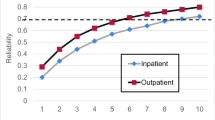Abstract
OBJECTIVE: Instruments available to evaluate attending physicians fail to address their diverse roles and responsibilities in current inpatient practice. We developed a new instrument to evaluate attending physicians on medical inpatient services and tested its reliability and validity.
DESIGN: Analysis of 731 evaluations of 99 attending physicians over a 1-year period.
SETTING: Internal medicine residency program at a university-affiliated public teaching hospital.
PARTICIPANTS: All medical residents (N=145) and internal medicine attending physicians (N=99) on inpatient ward rotations for the study period.
MEASUREMENTS: A 32-item questionnaire assessed attending physician performance in 9 domains: evidence-based medicine, bedside teaching, clinical reasoning, patient-based teaching, teaching sessions, patient care, rounding, professionalism, and feedback. A summary score was calculated by averaging scores on all items.
RESULTS: Eighty-five percent of eligible evaluations were completed and analyzed. Internal consistency among items in the summary score was 0.95 (Cronbach’s α). Interrater reliability, using an average of 8 evaluations, was 0.87. The instrument discriminated among attending physicians with statistically significant differences on mean summary score and all 9 domain-specific mean scores (all comparisons, P<.001). The summary score predicted winners of faculty teaching awards (odds ratio [OR], 17; 95% confidence interval [CI], 8 to 36) and was strongly correlated with residents’ desire to work with the attending again (r=.79; 95% CI, 0.74 to 0.83). The single item that best predicted the summary score was how frequently the physician made explicit his or her clinical reasoning in making medical decisions (r2=.90).
CONCLUSION: The new instrument provides a reliable and valid method to evaluate the performance of inpatient teaching attending physicians.
Similar content being viewed by others
References
Ende J. What if Osler were one of us? Inpatient teaching today. J Gen Intern Med. 1997;12(S2):S41-S48.
Evidence-based Medicine Working Group. Evidence-based medicine. A new approach to teaching the practice of medicine. JAMA. 1992;268:2420–5.
Barondess JA. Medicine and professionalism. Arch Intern Med. 2003;163:145–9.
Ahmed Mel-B K. What is happening to bedside clinical teaching? Med Educ. 2002;36:1185–8.
Irby DM. Clinical teacher effectiveness in medicine. J Med Educ. 1978;53:808–15.
Irby DM, Rakestraw P. Evaluating clinical teaching in medicine. J Med Educ. 1981;56:181–6.
Irby DM, Gilmore GM, Ramsey PG. Factors affecting ratings of clinical teachers by medical students and residents. J Med Educ. 1987;62:1–7.
Litzelman DK, Sratos GA, Marriott DJ, Skeff KM. Factorial validation of a widely disseminated educational framework for evaluating clinical teachers. Acad Med. 1998;73:688–95.
Copeland HL, Hewson MG. Developing and testing an instrument to measure the effectiveness of clinical teaching in an academic medical center. Acad Med. 2000;75:161–6.
Guyatt GH, Nishikawa J, Willan A, et al. A measurement process for evaluating clinical teachers in internal medicine. CMAJ. 1993;149:1097–102.
Williams BC, Litzleman DK, Babbott SF, Lubitz RM, Hofer TP. Validation of a global measure of faculty’s clinical teaching performance. Acad Med. 2002;77:177–80.
Arreola RA. Issues in developing a faculty evaluation system. Am J Occup Ther. 1999;53:56–63.
Green ME, Ellis CL, Fremont P, Batty H. Faculty evaluation in departments of family medicine: do our universities measure up? Med Educ. 1998;32:597–606.
Bland CJ, Wersal L, VanLoy W, Jacott W. Evaluating faculty performance: a systematically designed and assessed approach. Acad Med. 2002;77:15–30.
Fleiss JL. Reliability of measurement. In: The Design and Analysis of Clinical Experiments. New York: John Wiley & Sons; 1986:1–32.
Ramsey PG, Gillmore GM, Irby DM. Evaluating clinical teaching in the medicine clerkship. J Gen Intern Med. 1988;3:351–5.
Irby DM. What clinical teachers in medicine need to know. Acad Med. 1994;69:333–42.
Auerbach AD, Wachter RM, Katz P, Showstack J, Baron RB, Goldman L. Implementation of a voluntary hospitalist service at a community hospital: improved clinical efficiency and patient outcomes. Ann Intern Med. 2002;137:859–69.
Meltzer D, Manning WG, Morrison J, et al. Effects of physician experience on costs and outcomes on an academic general medicine service: results of a trial of hospitalists. Ann Intern Med. 2002;137:866–74.
Weingarten SR, Lloyd L, Chiou C, Braunstein GD. Do subspecialists working outside of their specialty provide less efficient and lower quality care to hospitalized patients than do primary care physicians? Arch Intern Med. 2002;162:527–32.
LaCombe MA. On bedside teaching. Ann Intern Med. 1997;126:217–20.
Kroenke K, Omori DM, Landry FJ, Lucey CR. Bedside teaching. South Med J. 1997;90:1069–74.
Ellis J, Rowe J, Sackett DL. Inpatient general medicine is evidence based. Lancet. 1995;346:407–10.
Michaud G, McGowan JL, van der Jagt R, Wells G, Tugwell P. Are therapeutic decisions supported by evidence from health care research? Arch Intern Med. 1998;158:1665–8.
Nordin-Johansson A, Asplund K. Randomized controlled trials and consensus as a basis for interventions in internal medicine. J Intern Med. 2000;247:94–104.
Pinsky LE, Irby DM. “If at first you don’t succeed”: using failure to improve teaching. Acad Med. 1997;72:973–6.
Pinsky LE, Monson D, Irby DM. How excellent teachers are made: reflecting on success to improve teaching. Adv Health Sci Educ Theory Pract. 1998;3:207–15.
O’Malley PG, Kroenke K, Ritter J, Dy N, Pangaro L. What learners and teachers value most in ambulatory educational encounters: a prospective qualitative study. Acad Med. 1999;74:186–91.
Wright S. Examining what residents look for in their role models. Acad Med. 1996;71:290–2.
Wright SM, Kern DE, Kolodner K, Howard DM, Brancati FL. Attributes of excellent attending-physician role models. N Engl J Med. 1998;339:1986–93.
Wright SM, Carrere JA. Excellence in role modeling: insights and perspectives from the pros. CMAJ. 2002;167:638–43.
Author information
Authors and Affiliations
Corresponding author
Additional information
Financial support came from the Department of Medicine, Cook County Hospital.
Rights and permissions
About this article
Cite this article
Smith, C.A., Varkey, A.B., Evans, A.T. et al. Evaluating the performance of inpatient attending physicians. J GEN INTERN MED 19, 766–771 (2004). https://doi.org/10.1111/j.1525-1497.2004.30269.x
Issue Date:
DOI: https://doi.org/10.1111/j.1525-1497.2004.30269.x




